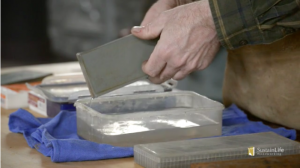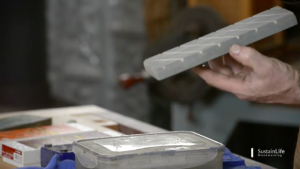I think that sharpening is one of the most important aspects to hand tool woodworking. As my tools become dull, I’ve found that the quality of my work also goes down. So therefore, it’s extremely important that your tools are razor sharp.
In this blog tutorial series, we’re going to go over sharpening all edge tools: chisels, planes, scrapers. We’ll also show you how to sharpen a crosscut saw and rip saw. We’ll talk about the different stones that are used: water stones, oilstones, diamond stones, and which ones I prefer. We’ll recondition tools and learn how to restore a chisel, a saw and a plane. We’ll talk about getting a tool fresh out of the box and how to get it working. So I hope you can join us for this new series on sharpening.
Sharpening Stones
The first step to sharp tools is the right sharpening stones. So here’s how to choose a sharpening stone, Part 1 of 4:
It may be confusing when trying to choose which sharpening stone system to use. So let’s try to clarify some of the confusion and simplify the process.
Water stones, oil stones, and diamond stones—those are the three main systems that are available to you. There are some other systems as well, including sandpaper on granite or glass and even ceramic stones. But these three are the primary systems that you’re going to meet when choosing your sharpening stones. I’ll talk about the pros and cons of each one of these stones.
Water Stones
Water stones are actually very friable; that is, that they break down quickly, always exposing a fresh sharpening surface. So when you’re sharpening, they sharpen quickly, but they often tend to hollow out rapidly, because you’re constantly breaking down the surface. So they need to be flattened; in fact, they need to be flattened most often after every sharpening.
They also use water to float the steel particles out so the stone doesn’t clog, so that can sometimes be a little messy when you’re sharpening. You’ve got to have the stone soaking in water. And you’ve got to always constantly check to make sure that it is flat.
Some of the main different grits you’ll find include the 220-grit Norton stone combined with a 1,000 grit, as well as a 4,000/8,000 grit combination. You will also find the stones in dedicated grits, and they can go all the way up to 15,000 grit!
If you were going to use the water stones, you would only need a couple. I would get a coarse one, maybe the 220-grit/1,000 combo and a fine one, say the 4,000/8,000 combo.
I personally don’t use the water stones because they’re time-consuming, messy, and I’d have to flatten them after every use. To flatten them, you have to use either a diamond flattener or a diamond stone. Norton does make their own type of flattener. And there are other brands that aren’t as soft as Norton water stones. Shapton makes one that’s a bit harder. But even with the harder ones, you still have the issue of needing to flatten them; generally quite often.
Another issue to consider when choosing your sharpening stones is that the grit configuration will vary from stone to stone. In other words, the Japanese Water stone grit configuration is often different then the American grit configuration. It is best, if you really want a good comparison, to use the micron system. Chris Schwarz just wrote about this on his blog and put a link to a nice little grit/micron chart.
What’s your experience with water stones? Please leave any comments and questions below.
Next post: Oil Stones.
Frank Strazza
See our sharpening stones video and full sharpening video course.



Comments are closed.